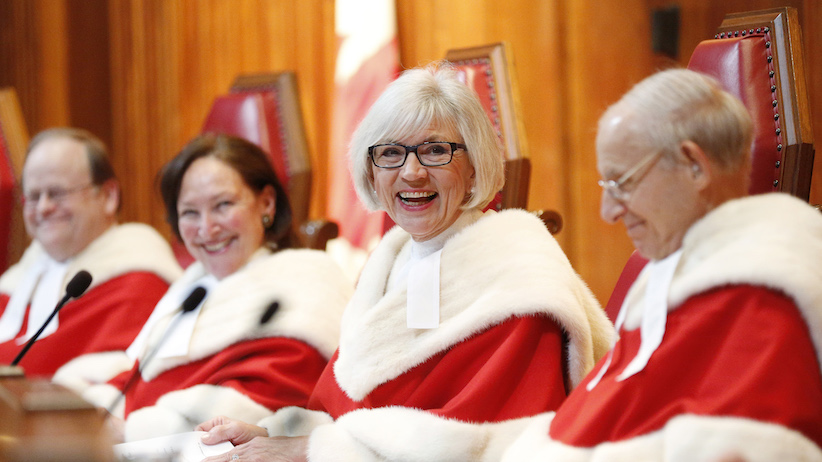How Beverley McLachlin changed the face of the Supreme Court
Her record conveying what the court was all about matters as much as her rulings
Chief Justice Beverley McLachlin (2nd R) takes part in a ceremony at the Supreme Court of Canada in Ottawa February 10, 2015. REUTERS/Blair Gable (CANADA) – RTR4P2K9
Share

In June of 2017, when it was announced that Chief Justice Beverley McLachlin would retire at the end of the year, Maclean’s Ottawa bureau chief, John Geddes, used the occasion to focus not only on her remarkable record as a judge but how she changed the Supreme Court’s public image.
Chief Justice Beverley McLachlin’s rulings have, just to touch on only a few famous cases, shored up freedom of expression, allowed the ongoing secrecy of certain government documents, and even permitted corporal punishment of children to continue. In other words, there’s lots there for legal scholars and the merely curious to pore over. She has been famously hard to pigeonhole politically, pleasing and annoying left and right by turns. As well, her push for collegiality, after she took over the court in 2000, largely erased the factional lines along which it had previously split. Yet it is impossible to think back on McLachlin’s run as chief justice without considering, not only how she ruled on cases or ran the court, but how she changed its public image.
In a 2010 interview with Maclean’s, she acknowledged that it wasn’t all bad for the courts to be “somewhat removed.” But she weighed the value of a certain distance against the problem of people seeing judges as impersonal “oracles,” and decided less aloofness would be better. And she acted on that instinct, webcasting Supreme Court hearings. “People tune in,” McLachlin said with obvious satisfaction, “and they say, ‘Who are those strange people sitting in their robes?’ and they learn a little about the court, and the civilized dialogue that goes on there.”
FROM THE ARCHIVES: A Q&A with Beverley McLachlin
This wasn’t just a matter of modern public relations. McLachlin feared that if ordinary people came to see the courts as out of touch, unsympathetic, aloof, then the rule of law would ultimately suffer. This was a pressingly important consideration in the Charter of Rights and Freedoms era, when tension between governments passing laws and courts sometimes overturning them is a constant. What if popular opinion came down on the idea that unelected judges should just butt out?
In a revealing speech, McLachlin stressed the need for the courts to open up, for judges to explain themselves, and to try to make it easier for journalists to cover their sometimes opaque proceedings. “The media, reporting accurately and fairly on legal proceedings and judgments, including criticism, even strong criticism, make an invaluable contribution to public confidence in the judiciary and, thus, to the rule of law itself,” she said.
But McLachlin’s tenure as chief justice also saw her exposed to the sort of unwelcome coverage that rarely goes, in Canada at least, with gowns and gavels. An unprecedented public feud erupted between McLachlin and former prime minister Stephen Harper over his attempt to appoint Marc Nadon to fill a vacant Quebec seat on the Supreme Court, a nomination the court itself rejected on the grounds that as a Federal Court judge, rather than a Quebec judge or practising lawyer, Nadon wasn’t eligible.
READ MORE: Stephen Harper, Beverley McLachlin and an historic mess
That episode passed without any obvious damage to McLachlin’s aura of balance, perhaps because she was so long-established by that time, and had given so many speeches and lectures and interviews in which she presented herself as a reasonable centrist. Born in Pincher Creek, Alta., in 1943, she studied law at the University of Alberta, and became a judge in British Columbia. There’s a bipartisan cast to her résumé: Brian Mulroney appointed her to the Supreme Court in 1989 and Jean Chrétien promoted her to chief justice in 2000. She was the first woman to have the job.
Somewhere in her long years working in the Supreme Court’s art deco-influenced building, designed by Montreal architect Ernest Cormier and completed in 1940, McLachlin became enthusiastic about the architecture itself. She spoke about the building and its surroundings in glowing terms, suggesting it embodied a heritage Canadians might take more pride in.
In 2014, she wrote a letter to the Public Works department (first reported on by Maclean’s) objecting to Harper’s plan to erect an imposing monument to victims of communism right next door, complaining the design “could send the wrong message within the judicial precinct, unintentionally conveying a sense of bleakness and brutalism that is inconsistent with a space dedicated to the administration of justice.”
Inside the Conservative government, especially on the heels of the Nadon affair, the letter seemed like a judge crossing a line. What was her stake in the issue? But, for those who had followed her closely over the years, McLachlin’s concern about what the planned monument (which the Liberals later moved to a less controversial location) was perfectly in character. She was a judge with an unusually acute interest in what conveyed the right message about justice.